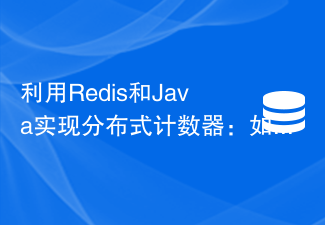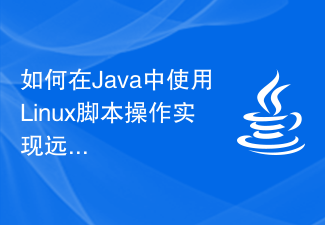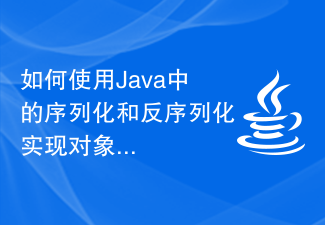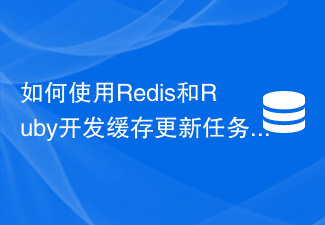 Java
Java javaTutorial
javaTutorial How to achieve persistence of objects using serialization and deserialization in Java?
How to achieve persistence of objects using serialization and deserialization in Java?How to use serialization and deserialization in Java to achieve object persistence?
Introduction:
In Java development, object persistence is an important way to achieve long-term storage of data. Serialization and deserialization are one of the commonly used ways to achieve object persistence in Java. This article will introduce the concepts of serialization and deserialization and how to use serialization and deserialization in Java to achieve object persistence.
1. What are serialization and deserialization?
Serialization is the process of converting an object into a byte stream so that the object can be copied and transmitted during operations such as network transmission or saving to disk. Deserialization is the process of re-converting a byte stream into an object and restoring the object's state and data. In Java, object serialization and deserialization is achieved by implementing the Serializable interface.
2. Serialization implementation methods
Java provides two main serialization methods, namely byte stream-based serialization and character stream-based serialization.
1. Serialization based on byte stream
Serialization based on byte stream can be implemented through the ObjectOutputStream and ObjectInputStream classes. The following is a sample code that demonstrates how to serialize and deserialize objects using a byte stream-based approach.
import java.io.*;
public class ByteStreamSerializationDemo {
public static void main(String[] args) {
// 将对象序列化为字节流
try {
// 创建一个待序列化的对象
Person person = new Person("Tom", 30);
// 创建一个输出流
FileOutputStream fileOutputStream = new FileOutputStream("person.obj");
ObjectOutputStream objectOutputStream = new ObjectOutputStream(fileOutputStream);
// 将对象写入输出流
objectOutputStream.writeObject(person);
// 关闭输出流
objectOutputStream.close();
} catch (IOException e) {
e.printStackTrace();
}
// 将字节流反序列化为对象
try {
// 创建一个输入流
FileInputStream fileInputStream = new FileInputStream("person.obj");
ObjectInputStream objectInputStream = new ObjectInputStream(fileInputStream);
// 读取对象数据
Person person = (Person) objectInputStream.readObject();
// 打印对象数据
System.out.println(person.getName()); // 输出:Tom
System.out.println(person.getAge()); // 输出:30
// 关闭输入流
objectInputStream.close();
} catch (IOException | ClassNotFoundException e) {
e.printStackTrace();
}
}
}
class Person implements Serializable {
private String name;
private int age;
// 构造方法、getter和setter省略
public Person(String name, int age) {
this.name = name;
this.age = age;
}
}In the above code, we first create a Person object to be serialized, then serialize the object into a byte stream through the FileOutputStream and ObjectOutputStream classes, and write it to a file. Next, we deserialize the byte stream in the file into an object through the FileInputStream and ObjectInputStream classes, and finally print out the object's attribute values.
2. Character stream-based serialization
Character stream-based serialization can be implemented through the ObjectWriter and ObjectReader classes.
import java.io.*;
public class CharacterStreamSerializationDemo {
public static void main(String[] args) {
// 将对象序列化为字符流
try {
// 创建一个待序列化的对象
Person person = new Person("Tom", 30);
// 创建一个Writer
FileWriter fileWriter = new FileWriter("person.txt");
BufferedWriter bufferedWriter = new BufferedWriter(fileWriter);
ObjectWriter objectWriter = new ObjectWriter(bufferedWriter);
// 将对象写入字符流
objectWriter.writeObject(person);
// 关闭字符流
objectWriter.close();
} catch (IOException e) {
e.printStackTrace();
}
// 将字符流反序列化为对象
try {
// 创建一个Reader
FileReader fileReader = new FileReader("person.txt");
BufferedReader bufferedReader = new BufferedReader(fileReader);
ObjectReader objectReader = new ObjectReader(bufferedReader);
// 读取对象数据
Person person = (Person) objectReader.readObject();
// 打印对象数据
System.out.println(person.getName()); // 输出:Tom
System.out.println(person.getAge()); // 输出:30
// 关闭字符流
objectReader.close();
} catch (IOException | ClassNotFoundException e) {
e.printStackTrace();
}
}
}
class Person implements Serializable {
private String name;
private int age;
// 构造方法、getter和setter省略
public Person(String name, int age) {
this.name = name;
this.age = age;
}
}In the above code, we serialize the object into a character stream through the FileWriter, BufferedWriter and ObjectWriter classes and write it to the file. Then, the character stream in the file is deserialized into an object through the FileReader, BufferedReader, and ObjectReader classes, and finally the object's attribute values can be printed out.
3. Notes
When using serialization and deserialization in Java to achieve persistence of objects, you need to pay attention to the following points:
1. The class of the object must be implemented Serializable interface, otherwise serialization and deserialization cannot be performed.
2. All referenced objects within the serialized class must also be serializable.
3. The fields of serialized and deserialized classes can be of any type, including custom classes, basic data types, collection types, etc.
4. Fields of serialized and deserialized classes can be transient-modified, and they will not be persisted.
Conclusion:
Through the introduction of this article, we have learned what serialization and deserialization are, and demonstrated through code examples how to use serialization and deserialization in Java to achieve object persistence. . In actual development, long-term storage and transmission of objects can be achieved by selecting a suitable serialization method according to needs and following serialization specifications and precautions.
The above is the detailed content of How to achieve persistence of objects using serialization and deserialization in Java?. For more information, please follow other related articles on the PHP Chinese website!
 如何使用Java开发一个基于Cassandra的地理位置数据应用Sep 20, 2023 pm 06:19 PM
如何使用Java开发一个基于Cassandra的地理位置数据应用Sep 20, 2023 pm 06:19 PM如何使用Java开发一个基于Cassandra的地理位置数据应用地理位置数据应用在现代社会中被广泛使用,例如地图导航、位置共享、位置推荐等。Cassandra是一个分布式、高可扩展性的NoSQL数据库,它能够处理海量数据,特别适合存储和查询地理位置数据。本文将介绍如何使用Java开发一个基于Cassandra的地理位置数据应用,并提供具体的代码示例。1.环境
 Java中如何使用LinkedList.removeFirst()方法从链表头部删除元素?Nov 18, 2023 am 11:10 AM
Java中如何使用LinkedList.removeFirst()方法从链表头部删除元素?Nov 18, 2023 am 11:10 AMJava中LinkedList类是一个实现了链表数据结构的类,它提供了许多有用的方法来操作链表。其中,removeFirst()方法可以用来从链表头部删除元素。下面将介绍如何使用LinkedList.removeFirst()方法,并且给出具体的代码示例。在使用LinkedList.removeFirst()方法之前,我们首先需要创建一个LinkedList
 在Linux中快速安装Kafka并进行入门:详细步骤指南Jan 31, 2024 pm 09:26 PM
在Linux中快速安装Kafka并进行入门:详细步骤指南Jan 31, 2024 pm 09:26 PMLinux环境下安装Kafka的详细步骤1.前提条件操作系统:Linux(推荐使用Ubuntu或CentOS)Java:JDK8或更高版本ZooKeeper:版本3.4或更高版本Kafka:最新稳定版本2.安装Javasudoapt-getupdatesudoapt-getinstalldefault-jdk3.安装ZooKeeperwg
 利用Redis和Java实现分布式计数器:如何实现高并发Jul 29, 2023 am 08:21 AM
利用Redis和Java实现分布式计数器:如何实现高并发Jul 29, 2023 am 08:21 AM利用Redis和Java实现分布式计数器:如何实现高并发引言:在现代互联网应用程序开发中,高并发是一个常见的挑战。当多个用户同时访问一个应用程序时,它需要能够正确地处理和跟踪每个用户的请求,以避免数据的丢失或混乱。在这篇文章中,我们将讨论如何利用Redis和Java实现一个分布式计数器,以实现高并发的数据跟踪和管理。一、Redis简介Redis是一个开源的基
 Java API 开发中使用 Dropbox 进行存储管理Jun 18, 2023 pm 01:21 PM
Java API 开发中使用 Dropbox 进行存储管理Jun 18, 2023 pm 01:21 PMJavaAPI开发中使用Dropbox进行存储管理随着云计算的广泛应用,越来越多的应用程序需要将数据存储在云端,并能够方便地读写和管理这些数据。而Dropbox作为最流行的云存储服务之一,提供了最为丰富和灵活的API,使得开发者能够方便地在自己的应用程序中集成Dropbox的存储管理功能。本文将介绍如何在JavaAPI开发中使用Dr
 如何在Java中使用Linux脚本操作实现远程登录Oct 05, 2023 am 08:42 AM
如何在Java中使用Linux脚本操作实现远程登录Oct 05, 2023 am 08:42 AM如何在Java中使用Linux脚本操作实现远程登录概述:远程登录是在网络环境中,使用一台计算机登录到其他计算机上进行操作的一种方式。在Linux系统中,我们通常会使用SSH协议来进行远程登录。本文将介绍如何在Java中通过调用Linux脚本来实现远程登录的操作,并给出具体的代码示例。步骤一:编写Linux脚本代码首先,我们需要编写一个Linux脚本,用于通过
 如何使用Java中的序列化和反序列化实现对象的持久化?Aug 02, 2023 pm 02:37 PM
如何使用Java中的序列化和反序列化实现对象的持久化?Aug 02, 2023 pm 02:37 PM如何使用Java中的序列化和反序列化实现对象的持久化?引言:在Java开发中,对象的持久化是实现数据长久存储的一种重要方式。而序列化和反序列化是Java中常用的实现对象持久化的方式之一。本文将介绍序列化和反序列化的概念以及如何使用Java中的序列化和反序列化实现对象的持久化。一、什么是序列化和反序列化?序列化是将对象转换为字节流的过程,使得对象在网络传输或保
 如何使用Redis和Ruby开发缓存更新任务Jul 31, 2023 pm 12:33 PM
如何使用Redis和Ruby开发缓存更新任务Jul 31, 2023 pm 12:33 PM如何使用Redis和Ruby开发缓存更新任务简介:在现代Web应用中,缓存是提高性能和减少响应时间的重要组成部分。Redis是一个高性能的键值数据库,可以用于快速读取和写入数据,并且它支持多种数据结构,如字符串、哈希表、列表等。在本文中,我们将探讨如何使用Redis和Ruby开发缓存更新任务,以实现更高效的缓存管理和更新。步骤1:安装和配置Redis首先,我


Hot AI Tools

Undresser.AI Undress
AI-powered app for creating realistic nude photos

AI Clothes Remover
Online AI tool for removing clothes from photos.

Undress AI Tool
Undress images for free

Clothoff.io
AI clothes remover

AI Hentai Generator
Generate AI Hentai for free.

Hot Article

Hot Tools

mPDF
mPDF is a PHP library that can generate PDF files from UTF-8 encoded HTML. The original author, Ian Back, wrote mPDF to output PDF files "on the fly" from his website and handle different languages. It is slower than original scripts like HTML2FPDF and produces larger files when using Unicode fonts, but supports CSS styles etc. and has a lot of enhancements. Supports almost all languages, including RTL (Arabic and Hebrew) and CJK (Chinese, Japanese and Korean). Supports nested block-level elements (such as P, DIV),

ZendStudio 13.5.1 Mac
Powerful PHP integrated development environment

Zend Studio 13.0.1
Powerful PHP integrated development environment

SublimeText3 Chinese version
Chinese version, very easy to use

Safe Exam Browser
Safe Exam Browser is a secure browser environment for taking online exams securely. This software turns any computer into a secure workstation. It controls access to any utility and prevents students from using unauthorized resources.





